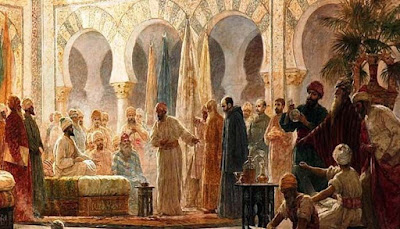Political and Diplomacy Conditions during the Umayyad Period
The Umayyad Caliphate was founded by Muawiyah bin Abi Sufyan in 41 Hijriah and ended in 132 AH. It can be said that the Umayyads ruled for 91 years. Historians have noted that the Umayyad caliphate was established through a process obtained through violence, diplomacy, trickery, and the election of a caliph not through democratic elections. The prominent names of the Umayyad caliphs were Muawiyah bin Abi Sufyan (661-680), Abd al-Malik ibn Marwan (685-705 AD), al-Walid ibn Abd al-Malik (705-715 AD), Umar ibn Abd al-Aziz (717-720 AD), and Hisham ibn Abd al-Maalik (724-743 AD).
Among the major, fundamental and strategic programs in the Umyyah era was the expansion of Islamic territory. In the era of Muawiyah Tunisa was conquered. In the east, Muawiyah can control the area of Khurasan to the Axus river and Afghanistan to Kabul. Its navy carried out attacks on the capitals of Byzantium and Constantinople. Muawiyah's expansion to the east was then continued by the Caliph Abd al-Malik. He sent soldiers across the Oxus river and managed to subdue Balkh, Bukhara, Khawarizm, Ferghana and Samarkand. His army even reached India and was able to control Balukhistan, Sind, and the Punyab area as far as Maltan.
Furthermore, massive expansion was continued during the time of al-Walid bin Abdul Malik. History records that the reign of al-Malik was a time of peace, prosperity, order and happiness. During his reign which lasted 10 years, it was noted that in 711 AD a military expedition was carried out from North Africa to the Southwest region of the European Continent. After al-Jazair and Morocco were subdued, Tariq bin Ziyad, the leader of the Islamic forces, crossed the strait that separated Morocco from the continent of Erofa, and landed in a place which is now known as Gibraltal.
The Spanish army was defeated and thus the Spanish capital of Kordofa was quickly captured as were other cities such as Seville, Elvira and Toledo. In the era of Umar bin Abd Al-Aziz, the expansion of the territory continued to France through the Piranee mountains, under Commander Abd al-Rahman Ibn Abdullah al-Ghafiqi. He began by attacking Boredeau, the Politiers, and on to Tours. However, in the battle that occurred in the city of Tours, al-Ghafiqi was killed, and his soldiers retreated back to Spain.
Through the various successes achieved in this expansion, the Islamic domain during the time of the Umayyads, in addition to the Arabian Peninsula and its surroundings, also reached Spain, Afghanistan, Pakistan, Turkemenia, Uzbeks, and Kyrgyzstan in Central Asia.
In the social and development fields, the Umayyads have succeeded in constructing various buildings for the needs of various fields. For example, when Muawiyah established postal services in certain places by providing horses complete with equipment. He also tried to put the armed forces in order and print currency. In his time, the special position of a qadli was a specialist in his field. Abdul Malik changed the Byzantine and Persian currencies used in areas controlled by Islam. For that, he printed his own currency in 659 AD using Arabic words and writings.
Caliph Abdul Malik also succeeded in reforming government administration and enforcing Arabic as the official language of Islamic government administration. Furthermore, in the era of al-Walid ibn Abd al-Malik (705-715) a strong-willed and capable man built homes for the disabled whose officers were paid by the state. In addition, al-Walid also built a highway that connects one area to another, factories, government buildings, and magnificent mosques.
In the religious field, the era of the Bani Umayyah was marked by the emergence of various religious sects with ideological political patterns. They include the Shi'a, Khawarij and various sects: Azariqah, Najdat Aziriyah, Ibadiyah, Ajaridah and Shafariyah, the Mu'tazilah, Maturidiyah, Asy'ariyah, Qadariyah, and Jabariyah groups. These various denominations and religious groups sometimes carry out movements and rebellions against the legitimate government. With Hussein killed in Karbela, the resistance of the Shiites never died down. Many rebellions were spearheaded by the Shi'ites. The famous ones were the Mukhtar rebellion in Kufa in 685-687 AD. Apart from that, there was also the Abdullah bin Zubair movement. He fostered his opposition movement in Mecca after he rejected an oath of allegiance to Yazid. However, he only declared himself openly as caliph after Husein ibn Ali was killed.
Apart from the aforementioned movements, the anarchist movement launched by the Khawarij and Shi'a groups can also be subdued. The success in eradicating the movement made the orientation of this dynastic government directed towards securing the territory of the eastern region which included cities around Central Asia and northern Africa, and even paved the way for conquering Spain.
The political, social and religious situation began to improve during the reign of Caliph Umar ibn Abd. Al-Aziz (717-720). When he was crowned caliph, he stated that improving and improving the quality of the country that is in the territory of Islam is better than increasing its expansion. This means that the main priority is domestic development. Despite his very short reign, Umar ibn Abd. Al-Aziz can be said to have succeeded in establishing good relations with the Shi'ites. He also gave freedom to followers of other religions to worship according to their beliefs and beliefs. Tax reduction and the position of Mawali (Muslims who are not of Arab descent, come from Persia and Armenia), equated with Arab Muslims
source: https://www.kompasiana.com/ghazi_01/5db]b1d541df028220a4c2/kondisi-politik-dan-diplomasi-pada-masa-bani-umayyah


0 Response to " Political and Diplomacy Conditions during the Umayyad Period"
Post a Comment